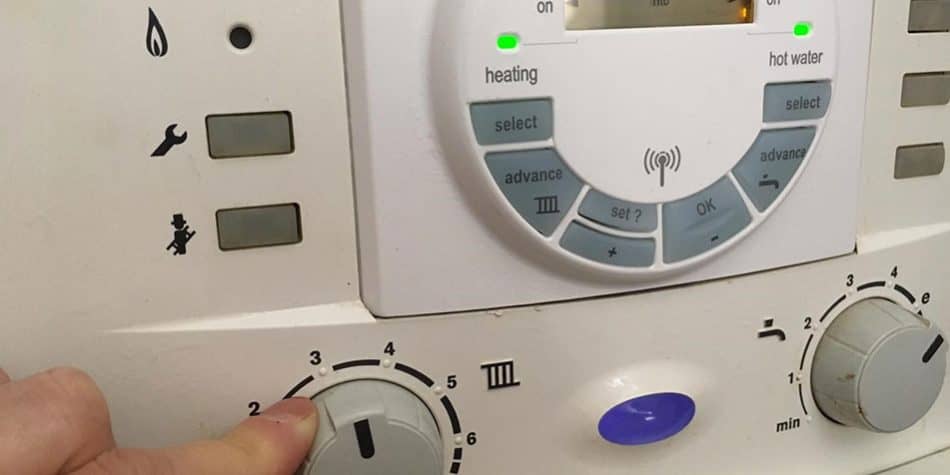Worried about rising energy bills? There is one extremely simple tweak you can make to save serious cash. According to Nesta, by turning down the heating FLOW temperature on your boiler, you can save around 9% on your gas bill. For the average household, this could work out to a saving of around £112 per year on their heating bill.
A trusted heating engineer will advise you that a combi boiler flow temperature should be set at 60°C or below for it to reach its higher efficiency potential. The working process of a gas combi boiler plays a significant role in its energy efficiency.
In fact, Nesta predicts that if 10 million households turned down the flow temperature on their combi boilers to 60°C or below, it could wipe £1 billion off UK energy bills and save 1.7 million tonnes of carbon emissions – the equivalent of nearly six million transatlantic flights.
Why 60°C? Most combi boilers do not run as efficiently as they could. For a combi to work at optimum efficiency it needs to be in ‘condensing mode’. When your boiler is in condensing mode it will recover heat that would otherwise be lost and will run more efficiently.
What is a condensing boiler?
A condensing boiler is a gas boiler that can work at a high efficiency rate. Non-condensing gas boilers could lose up to 40% of the heat they generate via the flue, whereas condensing boilers can recover most of the heat by trapping it before it leaves the flue and recycling it to pre-heat the boiler.
All central heating systems operate by sending hot water out into the radiators in one direction (called the flow) and receiving it back after it has travelled around the radiators (the return). A non-condensing heating system is set up to deliver heat to the radiators at 80°C (this is what we refer to as the boiler flow temperature). As the water ‘flows’ through the radiators about 20°C of heat is given off to the room and water ‘returns’ to the boiler at 60°C. These temperatures are far too high for condensing boilers to operate at as they will not be able to recover lost heat as effectively as they could.
Condensing boilers need to operate at a lower temperature compared to their non-condensing cousins to recover the lost heat. When the temperature of the water as it returns to the boiler is less than 60%, the boiler will run in what is known as ‘condensing mode’. This is when the boiler starts to recover its lost heat. Setting your boiler’s flow temperature to 60°C or less will ensure the water returns from radiators at a temperature low enough for it to stay in condensing mode.
What type of boiler do I need?
You will need to have a condensing combi boiler. A combi boiler produces your heat and hot water so you will not have a hot water cylinder. If your boiler was fitted in the last 16 years, it will be a condensing combi boiler, so you can make this easy tweak to the boiler flow temperature. For professional boiler installations, be sure to reach out to our experienced team.
How do I reduce the flow temperature?
If you look at the controls on the front of your boiler, you will see a thermostat. Depending on the type of boiler you have, it will either be a dial thermostat that goes from low to high (sometimes it is numbered), or more modern ones will have a digital display that you can adjust.
Nesta’s step-by-step guide is tailored to a user’s boiler control configuration so, it doesn’t matter what type you have, the guide will walk you through it in a few very simple steps. The guide is part of their Money Saving Boiler Challenge which aims to help over one million households change their combi boiler settings to save energy this winter.
Changing the flow temperature on a combi boiler will not:
- Affect the temperature of the hot water from your taps and showers.
- Affect warmth! It is not the same as turning down your thermostat, so it won’t make your home colder.
What changes in my heating system will I notice?
- Your radiators may be cooler to touch. This is normal and most homes can be heated effectively with slightly cooler rads.
- You may notice you are using less gas. Now your boiler is running more efficiently, you will be using less gas to heat up your house. This will be reflected in your energy usage and bills.
- Your home may take slightly longer to warm up. As your rads are cooler, your home will take a little longer to heat up than usual, but most people do not even notice a difference. Simply set your heating to come on twenty minutes earlier than you usually would. If your home still feels cooler you could try raising the flow temperature by 5°C for a few days to see if it improves. If needed, keep doing this until you find a temperature that suits you.
Want to save even more? Many homes can be heated at flow temperatures of less than 55°C. The lower you go, the more money and energy you will save.
Malcolm Osmore, Managing Director at Maintracts Services adds:
“During mild winter temperatures, keeping your boiler flow temperature at 60°C or below should keep your house nice and toasty. However, if you feel your house is not getting as warm as you need, turn up the temperature by 5°C and see how it feels. Turn up in increments of 5°C until you find your ideal temperature. It is important to find a flow rate that works for you, particularly if you are elderly or vulnerable.
One of the essential tips on preparing your home for winter is to close internal doors to stop heat from escaping, especially in unused rooms, and to close the curtains or shutters to block drafts. Additionally, if you have an open chimney that isn't in use, you should plug it with a chimney balloon to stop the warm air from escaping and the cold air from entering the room.
Reducing your boiler flow temperature will be the best adjustment you make this winter. All you need to do is adjust the controls on the front to make your boiler more efficient.”

If you would like one of our experienced Gas Safe registered boiler engineers to conduct a boiler service to check your heating system is working to optimum efficiency, we would be happy to arrange a visit. A standard boiler service conducted by one of our engineers is £98 + VAT but this will depend on the type of boiler being serviced. Catching a problem early or simply checking it is running efficiently can save you £££’s in the long term.

